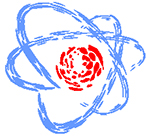Speaker
Mr
Yevgeniy Gorin
(Institute of Nuclear Physic Republic of Kazakhstan)
Description
Despite the success of radiation and chemotherapy of cancer, the problem of patient treatment with various forms of malignant neoplasms (multiform glioblastomas of the brain, gliomas, melanomas, their metastases and etc.) is still far from being solved, since all these types of treatment, as a rule, can damage sound as well as tumor tissues.
One of the most perspective methods of selective damage of cancer cells is neutron capture therapy of cancer (NCT). This treatment mode of cancer involves selective accumulation inside the cancer cells and irradiation by neutrons, resulting in collide and cause atomic fission, producing α-Ray radiation. Ideally, it is destroyed only tumor cells, including any amount of small metastases, without affection on a sound tissue. Among chemical elements with wide thermal-neutron capture cross-section, 10В (3838 barn) [1-3] and 157Gd (255000 barn) [4-5] are the most suitable due to their physical properties.
Among the variety of potentially suitable boron compounds for the BNCT and actively investigated in many research centers, a special place belongs to biochemical derivatives of carboranes, such as nucleoside bases [6-8].
In this work, carboarane containing nucleoside (deoxyadenosine, deoxyguanosine, deoxythymidine, deoxyuridine, deoxycytidine derivatives) were synthesized with potential converting these compounds into nucleotides and phosphorylation for success penitration inside the cancer cells, or incorporation into the nuclear of cancer cells DNA.
1. R. Barth, A. Soloway, R. Ferchild Bor neutron capture therapy of cancer, Science world,— 1990, 12, М: publishers “Mir”, p. 56–61
2. A. H. Soloway, R. F. Barth, R. A. Gahbauer, Т. Е. Blue, J. H. Goodman. The rational and requirements for the development of boron neutron capture therapy of brain tumors // Journal of Neuro-Oncology, 1997,33, pp. 9–18
3. R. V. Dorn. Boron neutron capture therapy (BNCT): A radiation oncology perspective //International Journal of Radiation Oncology, Biology, Physics.— 1994, 28, pp. 1189–1201.
4. T. Matsumoto. Transport calculations of depth-dose distributions for gadolinium neutron capture therapy //Physics in Medicine and Biology.— 1992, 37 (1), pp. 155–162.
5. B. J. Allen, B.J. McGregor, R. F. Martin. Neutron capture therapy with Gadolinium-157 // Strahlentherapie und Onkologie.— 1989, February/ March, Volume 165, No. 2/3, p. 156–158.
6. Feng-Guang Rong, Albert H. Soloway, Seiichiro Ikeda and David H. Ives. Synthesis and biochemical activity of hydrophilic carborane-containing pyrimidine nucleosides as potential agents for DNA incorporation and BNCT // NUCLEOSIDES & NUCLEOTIDES, 16(4), 379-401 (1997)
7. Michał Matuszewski, Agnieszka Kiliszek, Wojciech Rypniewski, Zbigniew J. Lesnikowski and Agnieszka B. Olejniczak. Nucleoside bearing boron clusters and their phosphoramidites – building blocks for modified oligonucleotide synthesis. // New J. Chem., 2015, 39, p.1202 - 1221
8. Hitesh K. Agarwal, Ahmed Khalil, Keisuke Ishita, Weilian Yang, Robin J. Nakkula, Lai-Chu Wu, Tehane Ali, Rohit Tiwari, Youngjoo Byun, Rolf F. Barth, Werner Tjarks. Synthesis and evaluation of thymidine kinase 1-targeting carboranyl pyrimidine nucleoside analogs for boron neutron capture therapy of cancer.// European Journal of Medicinal Chemistry 100 (2015) 197 - 209
Primary authors
Prof.
Aleksandr Kazantsev
(Institute of Nuclear Physic Republic of Kazakhstan, 050032, Ibragimov str., 1, Almaty, Kazakhstan)
Dr
Ilya Korolkov
(Institute of nuclear physics of Kazakhstan)
Mr
Yevgeniy Gorin
(Institute of Nuclear Physic Republic of Kazakhstan)

